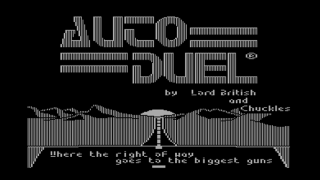«Mirax Force» for Atari 8-bit computers | Review
Developed by Chris Murray and published by Tynesoft in 1987, «Mirax Force» is a shoot-'em-up for Atari 8-bit computers, inspired by the classic Uridium on the C64. It was released at a time when the popularity of 8-bit systems was declining, with the market shifting towards 16-bit platforms like the Atari ST and Amiga. Despite this, it managed to stand out due to its technical innovation and gameplay, serving as an example of creativity within the independent scene of the time.
Aboard the Star Quest ship, you must fly—at a fixed altitude—over the surface of an enemy mothership, destroying key structures and facing waves of Martians. The enemy ship is ultimately destroyed by continuously firing at the large dome at the far end until it triggers a final explosion. Additionally, according to MobyGames, the game features a scoring system and changes background colors each time a life is lost. Unlike Uridium, which offered 15 levels named after metallic elements and a landing mini-game, «Mirax Force» focuses on destroying the main reactor in a more linear setting, with repetitive stages but color changes that break the monotony.
The screen scrolls horizontally in both directions, adding an extra layer of complexity as you must dodge obstacles like towers and buildings while engaging enemies. The speed of movement and the need for quick turns to avoid collisions demand precision and sharp reflexes.
Murray employed advanced techniques to maximize the capabilities of the Atari 8-bit’s limited hardware. He used display list interrupts to simulate multiple sprites with just one, achieving visually impressive effects for the time. In an interview, Murray explained that he had already experimented with techniques such as smooth horizontal scrolling and sound digitization, completing the game in just 56.5 hours according to his records.
The sound design is minimalist but effective. The sound effects, including gunfire and explosions, are simple yet fitting. One standout feature is the inclusion of digitized...
Aboard the Star Quest ship, you must fly—at a fixed altitude—over the surface of an enemy mothership, destroying key structures and facing waves of Martians. The enemy ship is ultimately destroyed by continuously firing at the large dome at the far end until it triggers a final explosion. Additionally, according to MobyGames, the game features a scoring system and changes background colors each time a life is lost. Unlike Uridium, which offered 15 levels named after metallic elements and a landing mini-game, «Mirax Force» focuses on destroying the main reactor in a more linear setting, with repetitive stages but color changes that break the monotony.
The screen scrolls horizontally in both directions, adding an extra layer of complexity as you must dodge obstacles like towers and buildings while engaging enemies. The speed of movement and the need for quick turns to avoid collisions demand precision and sharp reflexes.
Murray employed advanced techniques to maximize the capabilities of the Atari 8-bit’s limited hardware. He used display list interrupts to simulate multiple sprites with just one, achieving visually impressive effects for the time. In an interview, Murray explained that he had already experimented with techniques such as smooth horizontal scrolling and sound digitization, completing the game in just 56.5 hours according to his records.
The sound design is minimalist but effective. The sound effects, including gunfire and explosions, are simple yet fitting. One standout feature is the inclusion of digitized...
